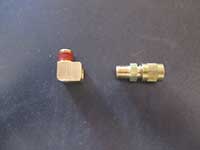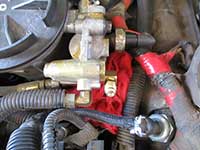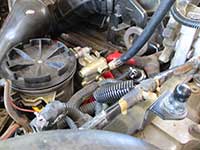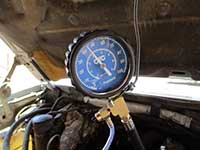Symptoms related to low fuel pressure include no start, hard start, excessive crank, low power/misfire under load, and rough idle conditions. If you're truck bucks or jerks during aggressive acceleration or while towing, the fuel pressure should be checked before any further diagnostics. Note that the following procedures are based on 1994.5 - 1998 model year engines. For later 1999 - 2003 Super Duty trucks, a schrader valve is not factory installed on the fuel pressure regulator like it is for earlier engines.
Note - the schrader valve fuel pressure test port is NOT a suitable location to install a permanent fuel pressure gauge. For such installations, refer to the gauge manufacturer's recommendations.
How to Test Fuel Pressure on a 7.3L Power Stroke Diesel
Click any thumbnail to view high resolution fullsize image w/ addition details (where applicable)
• The fuel test port schrader valve is located on the driver side of the fuel pressure regulator mounted to the fuel filter housing. If you're test gauge does not have a 90° angled fitting/adapter, you may need to remove the engine lift eye to access it. You can also install an elbow on the Shrader test port to reposition it.
• This is the brass 90° fitting that we installed. It needs a 1/8" NPT male fitting at one end and a 1/8" NPT female fitting at the other. Most hardware stores carry such fittings.
We're also installing an aftermarket schrader valve. The factory schrader valve can just as easily be installed onto the 90° fitting.
• The end result of our 90° fitting puts the test port in plain view with easy gauge access. The test port schrader valve is a standard size and compatible with most common fuel pressure gages.
• Connect the pressure gauge line to the schrader valve. The fitting on the pressure gauge line should have an o-ring seal and thus there's no reason to overtighten it.
• Position the gauge out of harms way such that it will not contact the fan or serpentine belt assembly; we hung ours from the hood latch.
• Start the engine and read the fuel pressure. 40 - 70 psi at idle is within spec. You may notice rapid fluctuations in the fuel pressure reading; this is completely normal for the mechanical fuel pump found on 1994.5 - 1998 model year engines. So long as the minimum pressure reading is greater than 40 psi, the fuel pressure is within spec.
• When finished reading pressure, remove the fuel gauge line and reinstall the safety cap on the fuel test port. Do not install or uninstall the pressure gauge with the engine running.




